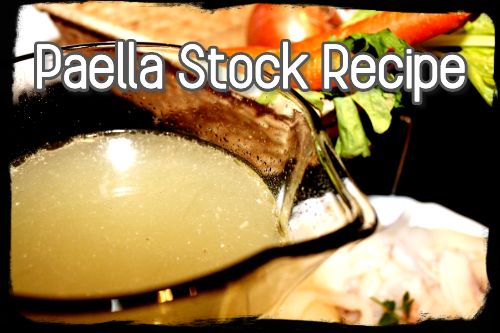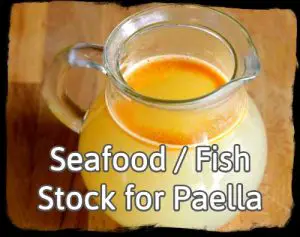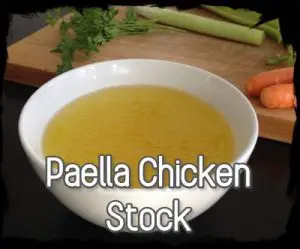Paella Stock Recipe is something to care about when you are learning how to make paella. If you have ever cooked rice boiled in the water you will have noticed that rice is tasteless.

However, I’m sure you have tried many paellas that almost made you cry with the emotion of how good and tasty it was. The secret? Well, one of the main ones is the paella stock recipe followed to cook the dish.
Besides, the sofrito (sauté), and of course the quality of the ingredients, are part of the key to success.
I’m going to show you all the secrets so you can master paella stock easily.
What is paella broth?
Paella broth is the secret of any Spanish rice dish. Thus, the elaboration of a good paella broth is essential when preparing a paella. A paella stock recipe will be based in water that took the flavor from other ingredients after boiling together. These ingredients are usually vegetables, meat, fish or seafood
Paella stock or water?
The traditional way to make paella uses water instead of stock. The reason is that the stock is made when cooking the paella, so, it needs more water and it takes more cooking time. Thus, if you want a proper Paella Valenciana, this is something remarkable.
However, I always recommend stock or broth basically for two main reasons:
- It eases the process drastically, as the rice/stock ratio it will be always the same.
- You don´t need bomba rice, which is the one recommended for this way of making paella.
How to make paella stock?
How to make paella stock is simple and straightforward. So, in general:
- Use a pot or a big casserole
- Fill it with water and introduce the ingredients. The pot should be well filled.
- Put it on high heat. Once it starts to boil, lower the heat so that it cooks slowly or moderately.
- Do not cook fish or shellfish broths for more than 25 to 30 minutes. Remove impurities frequently with a skimmer and the excess of fat with a large spoon.
- For meats or vegetables, the time can be longer but not excessive especially if you do it with chicken. For chicken and vegetables, 45 minutes is enough. In the case of meats or bones, you can have it up to several hours.
- Add half of the aromatic herbs halfway through cooking and the rest at the end or with the fire already off and let it cool down to take in the aromas.
- Do not add salt or put too little. It is better to rectify of salt during the cooking of the paella.
- Once cold, drain the excess fat and strain the broth.
- If you want a broth for darker or more intense paella, toast the ingredients previously in the pot until they take color or toast them in the oven.
The different broths can be used for different elaborations. E.g. in a mixed paella (meat and seafood) you can use a broth of poultry, seafood, or a mixture of both. Then, depending on the final result you want to obtain dare to try different combinations.
What kind of broth can you use in paella?
Then, what kind of broth can you use in paella? The kind of broth in paella varies. There are innumerable varieties of paella stock that can be made. However, the most common kinds are poultry or chicken broth, vegetable broth and fish and/or seafood broth. But in terms of broth origin, it could be:
- Water
- Homemade broth
- Commercial broth
- Stock / Broth cubes
Paella Chicken Stock is one of the most common ones because it is perfect for most meat paella recipes.
Fish Stock For Paella is key for a perfect seafood / fish-based paella such as seafood paella, black paella or prawn paella.
Water/stock considerations for paella
Although we consider rice to be the main product of paella, it would be useless without another indispensable ingredient: water.
In order to obtain a rich and tasty dish, we need rice to be cooked together with other ingredients. This will make rice to acquire its aromas and this must necessarily be done with water.
Water in Valencian Paella
For Valencian paella, as we said before, the most frequent thing is to add water directly for its elaboration.
Obviously, the better the water, the better the result. Remember that there are areas where the tap water’s quality is far from what is desirable.
Water in seafood paella
In the case of seafood products, such as lobster paella or seafood paella, instead of water, it will be added a broth that we have prepared previously. So, water will only be added if we want to reduce the taste if it has too much salt or a too powerful aroma.
How much water for paella?
Paella rice water ratio
Paella rice water ratio is a key point when making paella. So, calculate the water needed for the rice to be tender, tasty and at its exact point of cooking, is one of the most complicated tasks when making paella.
Generally, the ‘official rule’ is to use the same container to pour the rice and then the water, and to use twice as much water as the rice.
However, this is not always mathematically the perfect measure for paella at its point but it depends on other factors. For example, the hardness of the water mentioned above, the power of the fire during cooking, the type of ingredients we use to make it or the container chosen for our paella.
Water hardness
Each region or country has a different water hardness and this influences not only the kitchen but also other aspects such as cleanliness. So, if we are going to make our paella in another territory than usual, it’s a good idea to ask for the local water characteristics.
Power of heating
The stronger the fire, the faster we will make the water evaporate and therefore the rice should be made during this period of time.
The most recommendable thing is to vary the power of the fire throughout the cooking of the rice in the paella, putting it first to strong fire and then lowering it to medium or even soft fire.
The rice is usually made in about 18 minutes, so it is advisable to put during the first 8 minutes the high heat and then regulate it depending on how the grain has been made.
That is to say, in the remaining 10 minutes we will be “playing” with the power of the fire to make the water evaporate in that time; neither before nor after.
Ingredients used
It’s important to keep in mind that depending on the ingredients used for our paella, we will need more or less water. Why? Because all products contain water that is released during cooking, some of them more than others. E.G. vegetables always release much more water than meat or fish and this is added to the water we pour for cooking.
The Container
You have to take into account the size of the container we use to know the water necessary for the rice to be tender. Before making the paella, we can calculate how much water evaporates in the container to use during the time that more or less we are going to make this dish.
We can add 2 liters of water and put them to the same power that we will put our paella; with the quantity that remains to us passed that time, we will be able to know how many liquid evaporates according to the receptacle and the used power.



